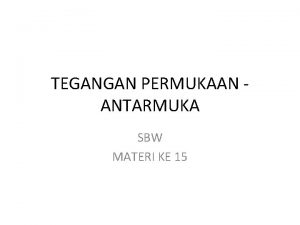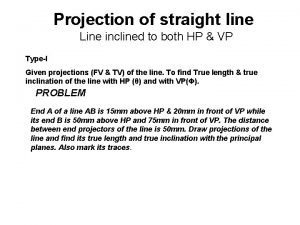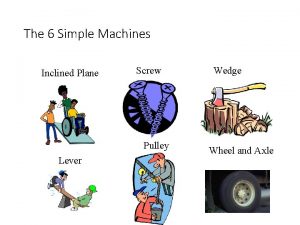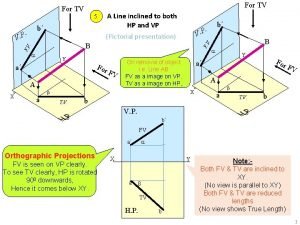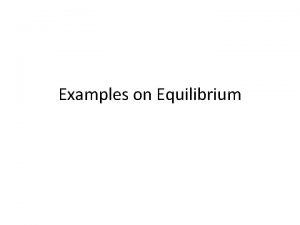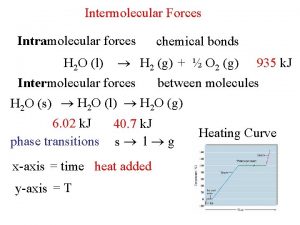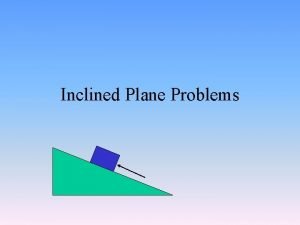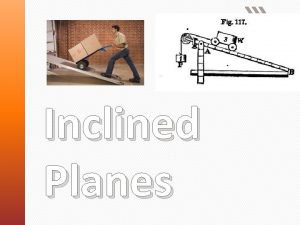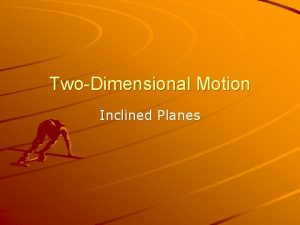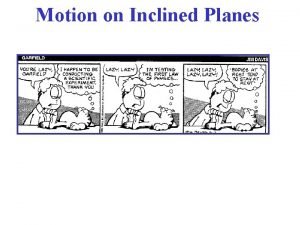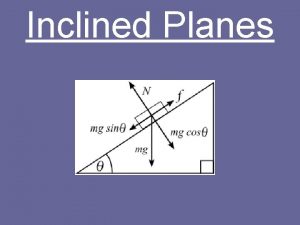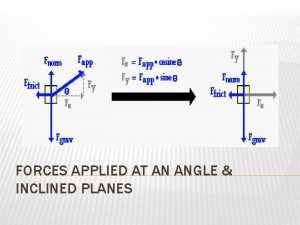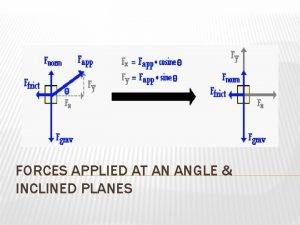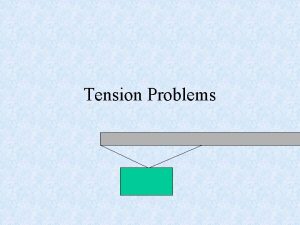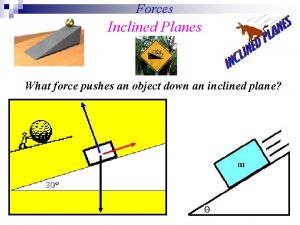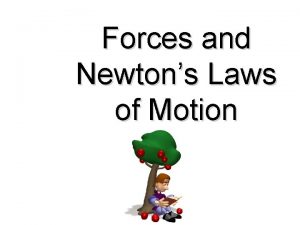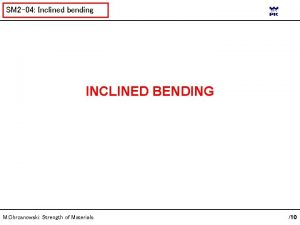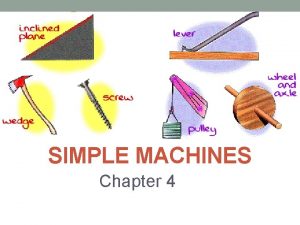Tension and Inclined Planes How to calculate forces























- Slides: 23

Tension and Inclined Planes How to calculate forces and direction in two dimensions

Inclined Planes and the abnormal force. We are used to having normal force be vertical when drawing a free-body diagram. How will this be different for inclined planes? Remember the Normal Force is always perpendicular to the surface, if the surface is at an incline so will be the normal force.

Gravity Force and its Components Determining net force for an object on an inclined plane can be difficult since the two (or more) forces are not directed in opposite direction. So we have to resolve them into perpendicular components. Usually, any force directed at an angle to the horizontal is resolved into horizontal and vertical components. However, this is not the case with inclined planes. Instead, we resolve the weight vector into two perpendicular components. Two components of force One parallel to the inclined surface One perpendicular to the surface.


The perpendicular component of the force of g is directed opposite the normal force, so it balances the normal force. The parallel component of the force of g is not balances by any other force. So it will accelerate down the inclined plane, due to the presence of an unbalanced force.

Determining the Magnitude of the two components of the g.

Sample Problem Answer A: F(g)=9800 N F(par)=6930 N F(per)=6930 N F(norm)=6930 N No other force parallel to the incline F(net)=6930 N A=6. 93 m/s/s

Answer to B F(grav)=9800 N F(par)=8487 N F(per)=4900 N The forces directed perpendicular to the incline balance each other. Thus, F(norm) is equal to F(per). F (norm) = 4900 N The is no other force parallel to the incline to counteract the parallel component of gravity. Thus, the net force is equal to the F(par) value. F(net) 8487 N, down the incline. A = 8. 49 m/s/s

Roller Coaster Physics Drops produce thrills! The large angles increase the parallel component of the weight vector. This is the component that causes acceleration. We feel weightlessness by reducing the magnitude of the normal force to a value less than their usual values. Weightlessness is a feeling associated with a lower than usual normal force. A person weighing 700 N will experience a 700 N normal force when sitting in a chair. However, if the chair were accelerating down a 60 degree incline than the person will experience a 350 N. normal force.

Tension and Two-Body Problems

Two-Body Problems involving two objects, connecting strings and pulleys are characterized by objects that are moving(or even accelerating) in different directions. They move or accelerate at the same rate but in different directions. Important, that we set up selecting an axes system for each individual object. We apply Newton’s laws to each object and the system.

Examples A 200. 0 -gram mass (m 1) and 50. 0 -gram mass (m 2) are connected by a string. The string is stretched over a pulley. Determine the acceleration of the masses and the tension in the string.

Answer: Direction: The more massive object will accelerate downward and the least massive object will accelerate upward. The magnitude of the acceleration will be the same for each object. For M 1= + y is downwards M 2= + y is upwards (this way acceleration is positive for both)

1. 960 - Ftens = 0. 2000 • a Ftens - 0. 490 = 0. 0500 • a Newton's second law equation (Fnet = m • a) can be applied to both diagrams in order to write two equations for the two unknowns. The Fnet will be expressed as the force in the direction of the acceleration minus the one that opposes it. So for the 200. 0 -gram mass, Fnet is written as 1. 960 N - Ftens. For the 50. 0 -gram mass, Fnet is written as Ftens - 0. 490 N. Equations 1 and 2 are the result of applying the Newton's second law equation to the 200. 0 -gram and 50. 0 gram masses. (Note that the mass values are converted to the standard kilogram unit before use in the equations. Also note that the units have been dropped in order for the equations to read more cleanly. )

From this point, a few steps of algebra lead to the answers to the problem. Equation 2 can be rearranged to develop an expression for Ftens written in terms of the acceleration F tens = 0. 0500 • a + 0. 490 This expression for Ftens can now be substituted into Equation 1 in order to change it into a single-unknown equation. That equation and the subsequent steps of algebra leading to the value of acceleration are shown below. 1. 96 - (0. 0500 • a + 0. 490) = 0. 2000 • a 1. 96 - 0. 0500 • a - 0. 490 = 0. 2000 • a 1. 47 = 0. 2500 • a a = 1. 47/. 2500 = 5. 88 m/s 2 Now that the acceleration has been found from Equation 1, its value can be substituted into Equation 3 in order to determine the tension. Ftens = 0. 0500 • (5. 88) + 0. 490 Ftens = 0. 784 N

Problem #2 Consider the two-body situation at the right. A 2. 50 x 103 -kg crate (m 1) rests on an inclined plane and is connected by a cable to a 4. 00 x 103 -kg mass (m 2). This second mass (m 2) is suspended over a pulley. The incline angle is 30. 0° and the surface is frictionless. Determine the acceleration of the system and the tension in the cable.

Fparallel = m 1 • g • sine(θ) = (2500 kg) • (9. 8 N/kg) • sine(30°) Fparallel = 12250 N Fgrav-2 = m 2 • g = (4000 kg) • (9. 8 N/kg) = 39200 N Fperpendicular = m 1 • g • cosθ = (2500 kg) • (9. 8 N/kg) • cos(30°) Fperpendicular = 21218 N

Ftens - 12250 = 2500 • a 39200 - Ftens = 4000 • a F tens = 2500 • a + 12250 39200 - (2500 • a + 12250) = 4000 • a 39200 - 2500 • a - 12250 = 4000 • a 26950= 6500 • a a = 26950/6500 = 4. 1462 m/s 2 a = ~4. 15 m/s 2

Ftens = 2500 • a + 12250 = 2500 • (4. 1462) + 12250 = 22615 N Ftens = ~2. 26 x 103 N

More Examples Consider the two-body situation at the right. A 100. 0 -gram hanging mass (m 2) is attached to a 325. 0 gram mass (m 1) at rest on the table. The coefficient of friction between the 325. 0 -gram mass and the table is 0. 215. Determine the acceleration of the system and the tension in the string.

For mass m 1: Fgrav = m 1 • g = (0. 3250 kg) • (9. 8 N/kg) = 3. 185 N Fnorm = Fgrav = 3. 185 N Ffrict = µ • Fnorm = (. 215) • (3. 185 N) = 0. 68478 N Ftens - 0. 68478 = 0. 3250 • a For mass m 2: Fgrav = m 2 • g = (0. 1000 kg) • (9. 8 N/kg) = 0. 9800 N 0. 9800 - Ftens = 0. 1000 • a a = 0. 69464 m/s 2 = ~0. 695 m/s 2 Ftens = 0. 91054 N = ~0. 911 N

Consider the two-body situation at the right. A 3. 50 x 103 -kg crate (m 1) rests on an inclined plane and is connected by a cable to a 1. 00 x 103 -kg mass (m 2). This second mass (m 2) is suspended over a pulley. The incline angle is 30. 0° and the surface has a coefficient of friction of 0. 210. Determine the acceleration of the system and the tension in the cable.

For mass m 1: Fgrav = m 1 • g = (3500 kg) • (9. 8 N/kg) = 34300 N Fparallel = m 1 • g • sine(θ) = 34300 N • sine(30°) = 17150 N Fperpendicular = m 1 • g • cosine(θ) = 34300 N • cosine(30°) = 29704. 67 N Fnorm = Fperpendicular = 29704. 67 N Ffrict = µ • Fnorm = (. 210) • (29704. 67 N) = 6237. 98 N 17150 N - 6237. 98 N - Ftens = (3500 kg) • a For mass m 2: Fgrav = m 2 • g = (1000 kg) • (9. 8 N/kg) = 9800 N Ftens - 9800 N - = (1000 kg) • a a = 0. 24712 m/s 2 = ~0. 247 m/s 2 Ftens = 10047 N = ~1. 00 x 104 N
 Spin coat
Spin coat Transference psychoanalysis
Transference psychoanalysis Pengertian tegangan antar muka
Pengertian tegangan antar muka Levers and inclined planes
Levers and inclined planes Two inclined planes joined back to back
Two inclined planes joined back to back Two inclined planes joined back to back
Two inclined planes joined back to back A line pq 100 mm long is inclined at 30
A line pq 100 mm long is inclined at 30 Examples of third class lever machines
Examples of third class lever machines Inclined plane pyramids
Inclined plane pyramids Simple machines on a bike
Simple machines on a bike Types of inclined planes
Types of inclined planes The six simple machines
The six simple machines Sample of inclined plane
Sample of inclined plane Line inclined to both hp and vp
Line inclined to both hp and vp Equilibrium
Equilibrium A clash between two opposing groups
A clash between two opposing groups Surface tension intermolecular forces
Surface tension intermolecular forces Liquid properties
Liquid properties Dipole induced dipole forces examples
Dipole induced dipole forces examples Forces acting on an inclined plane
Forces acting on an inclined plane Resultant of two unlike parallel forces
Resultant of two unlike parallel forces Force and motion
Force and motion Force examples in everyday life
Force examples in everyday life Destructive process examples
Destructive process examples


